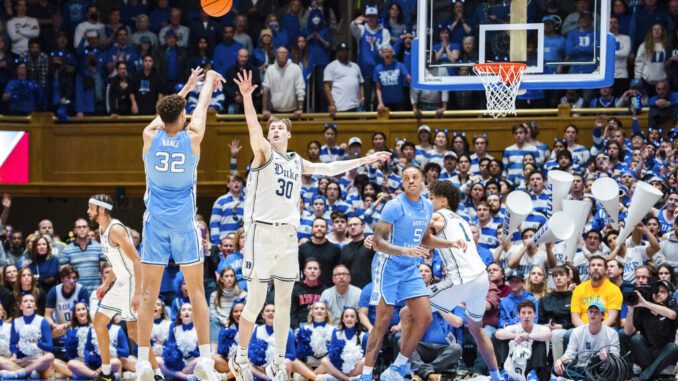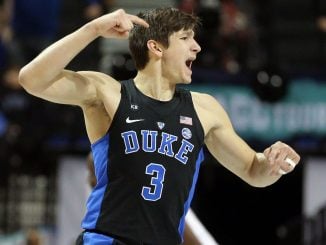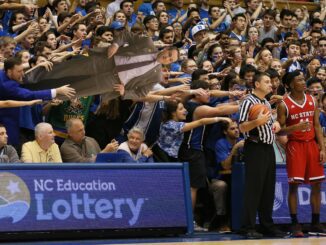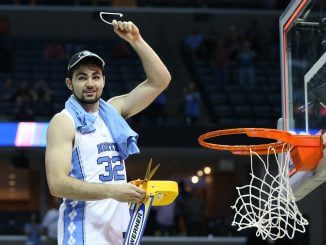
Duke’s 63-57 victory over UNC at Cameron Indoor Stadium over the weekend gave the Blue Devils bragging rights in the sport’s biggest rivalry, at least for a few weeks. It also gave Duke a leg up as the two teams jockey for position in the middle of the ACC.
In the other locker room, the game continued an uneven season for a Tar Heels squad that could be on a trajectory that puts it on the NCAA Tournament bubble. The loss also called attention, perhaps unintentionally, to issues with UNC’s offense this season.
On paper, the Carolina offense has plenty of bright spots. UNC is No. 44 in the nation in offensive efficiency. The Tar Heels don’t turn the ball over, ranking 14th in lowest turnover rate.
The Tar Heels are struggling with their outside shot, however. UNC’s .308 3-point accuracy is ranked 317th in the country. Despite that, more than a third of UNC’s shots have been from 3, giving the Heels an effective field goal percentage outside of the top 200 teams in the country.
The outside shooting problems seemed to hit a low point last week as the Heels took 27 3-point attempts in each of their losses, to Pitt and at Duke, accounting for 40% of all shot attempts. The Heels hit just 12 of those 54 3-point attempts for a .222 rate.
The overreliance on a shot that isn’t falling also exacerbates another area of the UNC offense that has been a weak spot: Carolina is relying heavily on getting to the free-throw line.
That was also evident in the Duke loss, as UNC coach Hubert Davis pointed out in his postgame press conference.
“I don’t think just because we shot 27 means that we turned into a 3-point shooting team,” Davis said. “The stat that I’m looking at is that going into the game we had shot 150 more free throws than any other opponent in our conference. We shot three; zero in the second half. That is what I’m looking at.”
The second-year UNC coach stopped short of criticizing the officiating, saying he was “just stating facts” as he repeated the “150 more but just three in the game” fact multiple times in his press conference. The message, however, was unmistakable.
Davis seemed to ignore the connection between the 3-point attempts and the lack of free throws. If the Tar Heels are launching two out of every five shots from deep, they aren’t driving the lane or getting the ball inside, where they’re more likely to draw fouls and put pressure on opposing defenses. The numbers this season bear this out. UNC has shot 24 or more 3-point attempts in 10 games, and the Tar Heels averaged 20 free throws in those games. In the 10 games with the fewest 3-point attempts, UNC has gone to the line an average of 27.9 times.
UNC has made no secret of the fact that getting to the line is a key component of its offense this season. That makes sense. The Tar Heels have a roster of good free-throw shooters, a pair of guards who can drive and draw fouls in RJ Davis and Caleb Love, and a big man who also draws his share of contact in Armando Bacot.
In general, teams loaded with offensive talent draw more fouls than their opponents, since it’s harder to defend them without grabbing and hitting. Nine of the last 10 NCAA Tournament champions drew more fouls than their foes, averaging 21% more free throws than the opposition.
The problem arises when the team leans too heavily on that one method of scoring. During tournament season, when teams may draw an officiating crew unfamiliar with its style, an overreliance on free throws could mean an early trip home. The Duke game, where officials seemed to allow more contact than usual on both ends, shows what can happen when officials don’t buy into the game plan.
UNC this season has gone to the line 64% more than its opponents. That’s a huge increase over last year when the Tar Heels went to the line 38% more often than opponents. It’s also far more than any team that won the title in the last 10 tourneys. The 2015 Duke team had the highest rate, getting 59% more free throws than its opponents. Kentucky in 2012 went to the line 53% more often. Both teams also had dominant big men in Jahlil Okafor and Anthony Davis, respectively.
UNC also gets 23.1% of its points from free throws. That’s 5% more than the Tar Heels got from the line last year, and it’s also more than teams that historically have cut down the nets. The last 10 champions got 18.9% of their points from free throws. UConn (22.4%) in 2014 came the closest to UNC’s rate.
As basketball moves away from reliance on a big man and more toward positionless players, reliance on the free throw has faded even more. While the last 10 champions shot 21% more free throws than opponents and got 18.9% of their points last way, the last five champions were at 13% and 16.8%, respectively.
In other words, what Hubert Davis saw as a problem in the Duke game may actually be a sneak preview of how Carolina’s season might end.



